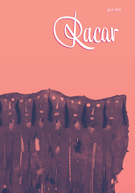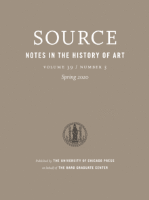
Lino - Revista Anual de Historia del Arte
metrics 2024
Fostering Scholarly Excellence in Visual Arts
Introduction
Lino - Revista Anual de Historia del Arte is a distinguished journal dedicated to advancing scholarly research in the fields of History and Visual Arts. Published by UNIV OVIEDO in Spain, this annual publication has been fostering academic dialogue since its inception in 2012 and continues to enrich the scholarly landscape through 2024. With its ISSN 0211-2574 and E-ISSN 2341-1139, the journal serves as an accessible repository for critical insights and innovative perspectives. As a member of the Q3 category in both History and Visual Arts and Performing Arts, it is poised to contribute significantly to ongoing discussions in these areas, despite its current standing in Scopus rankings. Lino's mission is to promote a deeper understanding of art history through rigorous research and high-quality publications that resonate with researchers, professionals, and students alike. The journal's commitment to scholarly excellence ensures that it remains a vital source of knowledge for those invested in the dynamic intersection of visual culture and historical analysis.
Metrics 2024
 0.11
0.11 -
- -
- 3
3Metrics History
Rank 2024
Scopus
JCI (Web Of Science)
Quartile History
Similar Journals

STORIA DELL ARTE
Delving into the Rich Tapestry of ArtSTORIA DELL ARTE is a notable journal dedicated to the rich exploration of art history and its varied facets, published by LUCA EDITORI ARTE ROMA. With an ISSN of 0392-4513, this publication serves as a vital resource for researchers, professionals, and students in the fields of Visual Arts and Performing Arts. Although the journal's coverage in Scopus has been discontinued from 2014, it has been recognized in the Scopus ranking as positioned within the 31st percentile among 374 entries in its category, highlighting its relevance in the realm of arts and humanities. While it does not offer open access, the journal's commitment to enriching the discourse on art history makes it an essential read for anyone interested in visual culture and historical contexts. Based in the heart of Rome, at VIA NOVELLA, 22, ROMA 00199 RM, ITALY, STORIA DELL ARTE continues to inspire scholarly discussion and contribute valuable insights to the academic community.

Eidola-International Journal of Classical Art History
Navigating the Intersection of Art and Historical Contexts.Eidola - International Journal of Classical Art History, published by Fabrizio Serra Editore, is dedicated to exploring the intricate connections between classical art and history. With an ISSN of 1824-6192 and an E-ISSN of 1826-719X, this journal stands as a pivotal resource for researchers, academics, and students within the realms of Classics, Visual Arts, and Performing Arts. Despite its recent establishment, having converged in the years 2019 to 2023, Eidola has carved out a place in various category quartiles, specifically achieving Q3 in Classics and Visual Arts and Q4 in History for 2023, indicating its growing influence in the field. Its Scopus rankings (Rank #163/170 in Classics and Rank #638/667 in Visual Arts and Performing Arts) further reflect its contribution to scholarly discourse, albeit in a competitive landscape. Though not openly accessible, the publication prioritizes substantial research, original scholarship, and critical reviews that enhance the understanding of classical art within broader historical contexts. For anyone invested in the dialogues surrounding art history, Eidola presents a vital avenue for engagement and scholarly exploration.

Eikon Imago
Cultivating Innovative Research in Visual and Performing Arts.Eikon Imago is an esteemed academic journal published by Universidad Complutense de Madrid, Facultad de Geografía e Historia, focusing on a diverse range of subjects within the Arts and Humanities. With an ISSN of 2254-8718 and an e-ISSN matching its print counterpart, the journal embraces an Open Access model since 2012, ensuring that its rich content remains freely accessible to researchers, professionals, and students around the globe. Lauded for its rigorous contributions to the fields of History, Religious Studies, and Visual Arts and Performing Arts, Eikon Imago has achieved notable rankings, including Q3 in several categories and a commendable position within the Scopus metrics, emphasizing its relevance and impact. With a commitment to interdisciplinary scholarship, the journal provides a valuable platform for innovative research and critical discourse, fostering a deeper understanding of cultural phenomena. As it converges through the years from 2019 to 2024, Eikon Imago continues to play a pivotal role in shaping the academic landscape of the humanities.

Imafronte-Revista de Historia del Arte
Exploring the Depths of Artistic HeritageImafronte-Revista de Historia del Arte is a premier scholarly journal published by the University of Murcia, dedicated to advancing the field of art history. With an ISSN of 0213-392X and an E-ISSN of 1989-4562, this open-access journal has been serving the academic community since 1985, ensuring that research is widely available and accessible. Nestled in the heart of Spain at the Campus de Espinardo in Murcia, Imafronte invites contributions that span a myriad of topics within art history, providing a rich platform for critical analysis and interdisciplinary dialogue. Its commitment to fostering scholarly communication and innovation makes it an essential resource for researchers, professionals, and students alike, eager to explore the nuances of artistic heritage and contemporary discourse in the arts.

Baltic Journal of Art History
Engaging Minds with Pioneering Art Historical ResearchBaltic Journal of Art History is a prominent academic journal published by UNIV TARTU PRESS, focusing on the rich tapestry of art historical research within the Baltic region and beyond. With its ISSN 1736-8812 and E-ISSN 2346-5581, the journal serves as a vital platform for scholars, artists, and historians to disseminate innovative findings and critical analyses in the fields of History and Visual Arts and Performing Arts. Established in 2017, it has gained recognition in academic circles, achieving a Q3 ranking in History and a Q2 ranking in Visual Arts and Performing Arts as of 2023. Despite not being open access, the journal continues to attract a diverse readership eager to engage with its rigorous, peer-reviewed content. Situated in Estonia, the journal not only enriches the regional scholarly discourse but also contributes significantly to global conversations on art history. Positioned at a pivotal intersection of various disciplines, the Baltic Journal of Art History invites researchers and practitioners alike to explore the aesthetic and cultural narratives that shape our understanding of art.

Umeni-Art
Unveiling Artistic Insights for Future GenerationsUmeni-Art is a prominent journal in the field of visual arts and performing arts, published by the Institute of Art History, Academy of Sciences, Czech Republic. With its ISSN 0049-5123 and E-ISSN 1804-6509, the journal has established itself as a critical platform for scholarly discourse and artistic expression since its inception in 2002. Although currently classified in Q4 within the Arts and Humanities category, it aims to elevate the understanding and appreciation of the arts through rigorous research and innovative perspectives. The journal's Scopus ranking places it at Rank #573/667, reflecting its growing contribution to the field and expanding reach within the artistic community. With a focus on fostering collaboration among researchers, practitioners, and students, Umeni-Art seeks to enrich the academic landscape with significant findings and discussions that inspire future research and creative endeavors. While it does not offer open access, the journal remains a valuable resource for those vested in exploring the dynamic interplay between art, culture, and society in the contemporary context.

RACAR-REVUE D ART CANADIENNE-CANADIAN ART REVIEW
Unveiling the Rich Tapestry of Canadian CultureRACAR - Revue d'Art Canadienne (Canadian Art Review), published by the University Art Association of Canada, stands as a pivotal academic journal in the field of Canadian art history and cultural studies. With its ISSN 0315-9906 and E-ISSN 1918-4778, RACAR serves as a vital platform for scholarly research and discourse, aiming to illuminate the rich tapestry of Canada's artistic heritage. Although not an open-access journal, it is committed to disseminating high-quality peer-reviewed articles that contribute to the ongoing dialogue about art in Canada. The journal's focus encompasses a diverse range of topics, from contemporary visual arts to historical investigations, appealing to researchers, professionals, and students alike. Based at the Department of History in Art at University of Victoria, RACAR fosters a critical understanding of Canadian art within broader national and global contexts, making it an essential resource for anyone engaged in this vibrant field of study.

Artibus et Historiae
Illuminating Visual and Performing Arts ScholarshipArtibus et Historiae is a distinguished academic journal published by IRSA PUBLISHING HOUSE, focusing on the fields of Visual Arts and Performing Arts within the broader scope of Arts and Humanities. With an ISSN of 0391-9064, this journal has become a crucial platform for the dissemination of scholarly research, critical discourse, and innovative ideas in art history and visual culture. Though its coverage in Scopus was discontinued in 2018, it maintained a respectable ranking of #279 out of 502 in its category, placing it in the 44th percentile. This positions Artibus et Historiae as a respected contributor to scholarly conversations in its field. Researchers, professionals, and students will find valuable insights and analyses that deepen their understanding of artistic practices and historical contexts. While not an open-access journal, it aims to bridge the gap between academia and broader audiences interested in the dynamic interplay of art and history.

SOURCE-NOTES IN THE HISTORY OF ART
Illuminating the Threads of Artistic HeritageSOURCE-NOTES IN THE HISTORY OF ART is a vital publication in the field of visual arts and performing arts, managed by the prestigious University of Chicago Press. With its ISSN 0737-4453 and E-ISSN 2328-207X, the journal serves as a scholarly platform for researchers, professionals, and students who are passionate about exploring the intricacies of art history. Although it currently holds a Q4 ranking in 2023, it provides a unique contribution by documenting and analyzing various dimensions of artistic endeavors, from historical references to contemporary practices. Despite being a newer entrant in the academic landscape, its focus on detailed source notes allows for deeper understanding and connections within art scholarship. Situated in the heart of Chicago, a city rich in artistic heritage, this journal is committed to promoting critical discourse and fostering awareness of the evolving narratives in art history. As the journal continues to cultivate rigorous academic dialogue, it stands as an essential resource for those dedicated to advancing and enriching the study of the arts.

Vestnik Sankt-Peterburgskogo Universiteta-Iskusstvovedenie
Fostering Dialogue in Conservation and Artistic ExpressionVestnik Sankt-Peterburgskogo Universiteta-Iskusstvovedenie, published by ST PETERSBURG UNIV PRESS, is a distinguished academic journal based in the Russian Federation, focusing on the interconnected disciplines of Conservation, History, Music, and Visual Arts and Performing Arts. With an ISSN of 2221-3007 and E-ISSN of 2542-2243, this journal plays a vital role in disseminating scholarly research and fostering dialogue across these fields. Despite being categorized in the third quartile (Q3) in 2023 across its respective disciplines, its significance lies in publishing emerging research and critical analyses that contribute to the academic discourse. The journal accepts submissions until the converged years spanning 2016 to 2024, making it a relevant platform for current academic inquiry. Although it currently does not offer open access, the journal provides robust insights for researchers, professionals, and students eager to explore the nuances of cultural heritage and artistic expression. As it continues to develop its impact within the arts and humanities, Vestnik Sankt-Peterburgskogo Universiteta-Iskusstvovedenie remains an essential resource for those passionate about understanding and preserving the rich tapestry of artistic endeavors.